
Bluetooth Technology Vulnerabilities in IoT Environments
Explore the security vulnerabilities in Bluetooth technology as used in IoT devices. Learn about Bluetooth versions, major threats, common attacks, and recommendations to secure Bluetooth communications in the realm of Wireless Networks Security.
Download Presentation

Please find below an Image/Link to download the presentation.
The content on the website is provided AS IS for your information and personal use only. It may not be sold, licensed, or shared on other websites without obtaining consent from the author. If you encounter any issues during the download, it is possible that the publisher has removed the file from their server.
You are allowed to download the files provided on this website for personal or commercial use, subject to the condition that they are used lawfully. All files are the property of their respective owners.
The content on the website is provided AS IS for your information and personal use only. It may not be sold, licensed, or shared on other websites without obtaining consent from the author.
E N D
Presentation Transcript
SECURITY VULNERABILITIES IN BLUETOOTH TECHNOLOGY AS USED IN IOT CSE 707 - Wireless Networks Security, Principles and Practices Presented by Group - 3, Dharshini Adimoolam Suraj Jaganathan 1
Paper Title: Security Vulnerabilities in Bluetooth Technology as Used in IoT Published Date 19 July 2018. Authors - Angela M. Lonzetta 1, Peter Cope 2, Joseph Campbell 2, Bassam J. Mohd 3 and Thaier Hayajneh 1. 1. Fordham Center for Cybersecurity, Fordham University, New York, NY 10023, USA; alonzetta@fordham.edu 2. Computer Science Department, New York Institute of Technology, Old Westbury, NY 11568, USA; pcope@nyit.edu (P.C.); jcampb01@nyit.edu (J.C.) 3. Computer Engineering Department, Hashemite University, Zarqa 13133, Jordan; Bassam@hu.edu.jo 4. Correspondence: thayajneh@fordham.edu; Tel.: +1-212-636-7785 2
Bluetooth Background knowledge Bluetooth Versions Overview of Bluetooth Technology Bluetooth Piconet AGENDA Protocol Stack for versions 1,2,3 & 4 Bluetooth Security Major Bluetooth Vulnerabilities and Threats Common Bluetooth Attacks Commercial Product Samples Recommendations to Secure Bluetooth Communications. 3
Bluetooth was invented in the year 1994 at Ericsson. In 2000, the first Bluetooth-enabled device was arrived in stores. A Complementary version of Bluetooth is called as Bluetooth Low Energy (BLE). HISTORICAL BACKGROUND Bluetooth Low Energy (BLE): Bluetooth Low Energy is a wireless personal area network technology. Compared to Classic Bluetooth, Bluetooth Low Energy is intended to provide considerably reduced power consumption and cost while maintaining a similar communication range. 4
BLUETOOTH VERSIONS Bluetooth 1.1 and 1.2 are Basic Rate(BR) which has a transmission speed of 1 Mbps. Bluetooth version 2.0 is known as Enhanced Data Rate(EDR) which has a transmission speed up to 3 Mbps. Bluetooth Version 3.0 is known as High Speed(HS) which allows transmission speed up to 24 Mbps. Bluetooth version 4.0 also known as Bluetooth Low Energy allows a transmission speed of 1Mbps with a lower power consumption. Bluetooth 4.1 and 4.2 are the most updated versions of Bluetooth which provides both Low Energy and BR,EDR and HS. Version 4.1 provides a speed in the range of 1-3Mbps while version 4.2 provides 1Mbps. Bluetooth technology is constantly evolving, with new versions adding features like Periodic Advertising with Responses (PAwR) and Encrypted Advertising Data (EAD). 5
OVERVIEW OF BLUETOOTH TECHNOLOGY Bluetooth Frequency and Connectivity Ranges: Bluetooth operates in unlicensed RF in 2.4 GHz spectrum between the range of 1m to 100m. There are 3 classes of devices that provides 3 different connectivity ranges, Class 1 - These Devices offers a range of 100 m and transmit at 100 mW. Class 2 Offers a range of 10 m and transmit at 2.5 mW. Class 3 Offers a range of about 1 m and transmit at 1 mW. Coexistence with other wireless technologies has significantly impacted Bluetooth signals, causing interference. To mitigate this Bluetooth Technology uses hops (1600 hops per second) and spread spectrum technology to avoid interference. 6
BLUETOOTH PICONET Communication between devices by the formation of a Bluetooth network. A piconet is a spontaneous, ad hoc network that enables two or more Bluetooth devices to communicate with one another. In the network, one device is designated as the master, while all other devices are designated as slaves. These devices can request and transmit data to the master device. The connection between a cell phone (master) and a smartwatch (slave) is an example of a simple Bluetooth piconet. 7
BLUETOOTH PROTOCOL STACK The highest level of the protocol stack is the application layer where the application interact with the Bluetooth. The second is the tcp, udp and Ip protocols which handles the data transfers over the network. RFCOMM is the radio frequency protocol which creates a virtual serial ports to make it easy to communicate as if they were connected by a physical serail cable. Then comes the SSDP which allows Bluetooth devices to discover other devices. L2CAP is the logical link and adaptation protocol which handles the data packets that needs to be transmitted between devices. It breaks the larger chunks of data in smaller segments and reassembles it in the receiving end. The Host controller interface acts as a bridge passing commands between the software side and the hardware side. Link management protocol is responsible for managing the Bluetooth link between Bluetooth Protocol Stack for Versions 1, 2 and 3. devices. Finally, the Bluetooth radio is the hardware component that transmits and receives 8 data via Bluetooth.
BLUETOOTH PROTOCOL STACK The key difference between the previous version's and this updated version 4is that, Generic Access Profile (GAP): This layer handles how Bluetooth devices interact and manage connections. This is crucial for BLE because it defines how devices like fitness trackers or smart home devices efficiently connect with smartphones or computers. Generic Attribute Profile (GATT): This is specific to BLE and manages how data is organized and exchanged between two devices. Attribute Protocol - This protocol is used for discovering and accessing attributes on a connected device. Security Manager (SM): While older versions had basic security, BLE has its own Security Manager, responsible for encryption and ensuring secure connections. This is important for devices like IoT sensors, which require secure but lightweight communication. Bluetooth Protocol Stack for Version 4. 9
BLUETOOTH SECURITY NIST 800-121 R1 and IEEE 802.15.1 are the 2 guides and standards for Bluetooth. NIST 800-121 R1 Provides detailed Bluetooth security processes. IEEE 802.15.1 is a standard for Bluetooth Wireless Technology. BLUETOOTH SECURITY SERVICES BUILT-IN SECURITY FEATURES BLUETOOTH SECURITY MODES BLUETOOTH TRUST MODES DISCOVERABILITY IN DEVICES 10
BLUETOOTH SECURITY MODES: Security Mode 1 Non-Secure Security Mode 2 Enforces basic security services such as authentication, confidentiality and authorization. Security Mode 3 Link Level enforced security. Modes 1 and 3 does not specify service security levels. Security Mode 4 Service level enforced security with encrypted key exchange. It has 5 levels of service security such as SHA-256 for hashing, AES-CCM for encryption and Secure Simple Pairing for key generation. BLUETOOTH TRUST MODES: There are 2 levels of trust modes, Trusted Device A has a fixed relationship with Device B and gets unrestricted access to all services. Untrusted Device A has restricted access only to a set of services. No fixed relationship with Device B. DISCOVERABILITY IN DEVICES: Devices in discoverable mode are more vulnerable because the device name, class, list of services, technical information and a unique 48-bit address known as BD_ADDR used for identification are all exchanged during this mode. This BD_ADDR is assigned by the manufacturer. 11
BLUETOOTH SECURITY SERVICES Device 1 and device 2 create the initialization key KINIT using a secret PIN and a random input IN_RAND with encryption E22 and E23 respectively. In device 1 Another Random value for Link key LK_RAND1 is XORed with kINIT and the result combination COMB_KEY1 is exchanges with device 2 s COMB_KEY2. Secret Keys K1 and K2 are created in both devices. Device 1: The random link number and Bluetooth address of device 1 is encrypted (LK_RAND1 and BD_ADDR1 with E22 -> K1) to produce secret key 1. The Combination key from device 2 is XORed with device 1 s initialization key and encrypted with Bluetooth address of device 2 to produce secret key 2. (COMB_KEY2 XOR KINIT and BD_ADDR2 with E21 -> K2) Finally, the Link Key KLINK is generated by XORing K1 and K2. Device 2: The random Link number and Bluetooth address of device is encrypted with to produce secret key 2 (LK_RAND2 and BD_ADDR2 with E21 -> K2). The combination key is XORed with initialization key and encrypted with Bluetooth address of device 2 with E21 to produce secret key 1 (COMB_KEY2 XOR KINIT and BD_ADDR1 with E21 -> K1). LINK-KEY GENERATION WITH PIN Finally, the Link key KLINK is created by XORing K1 and K2. Link keys in both devices is stored for comparing and verifying during every communication If these devices are trusted devices none of the above steps is done. 12
Elliptic curve cryptography is used to encrypt private key of device 1 and public key of device 2 to produce the shared secret key KOH . Same is done for device 2. In authentication stage 1, some values are exchanged like Bluetooth addresses, random input numbers and shared secret keys KOH. In authentication stage 2, they are encrypted as E1 and E2 in device 1 and device 2 respectively. LINK-KEY ESTABLISHMENT FOR SSP They are then exchanged for verifying. The nonces are finally hashed in both devices to generate link keys KLINK. 13
BUILT-IN SECURITY FEATURES There are 4 built-in features, Adaptive Frequency Hopping The ability to frequency hop reduces both jamming and interference. E0 Cipher Suite The cipher generally has a key length of 128 bits and uses stream ciphering Undiscoverability - This prevents devices from responding to scanning attempts. A device s 48-bit BD_ADDR address is also concealed. Pairing Pairing enables devices to communicate. 14
BLUETOOTH VULNERABILITIES AND THREATS 15
VULNERABILTIES IN BLUETOOTH VERSIONS The device with the oldest (weakest version) is important when discussing Bluetooth vulnerabilities. Vulnerabilities in Each Version: Versions before Bluetooth 1.2 Link keys are used for pairing and can be reused. Versions before Bluetooth 2.1 + EDR Codes that consist of short PINs are permitted. The keystreams in these early versions become vulnerable after being connected for 23.3 h. Versions 2.1 and 3.0 If Security Mode 4 devices are connecting to devices that do not support Security Mode 4, earlier security modes are used in the connection. These version uses SSP static keys and is more vulnerable to MITM attacks. Versions before Bluetooth 4.0 Numerous authentication challenge requests enables adversaries to gain insight on secret link keys. All versions of Bluetooth: Improper storage of Link keys. Small key lengths makes the encryption vulnerable. Includes only device authentication, no user authentication is required. 16 A device can remain in discoverable mode when the device is ON.
COMMON BLUETOOTH ATTACKS 17
MAN IN THE MIDDLE ATTACK The Legitimate User tries to connect with the target device. The MITM disrupts the PHY layer, causing pairing attempts to fail. Link Key deletion and downgrading might occur if pairing fails, resetting the security between the two devices. The devices reattempt a connection and exchange capabilities twice. Pairing uses the Just Works model, which is vulnerable to MITM attacks due to the lack of user authentication. The pairing completes, but if the MITM successfully intervened, they could now monitor or control the communication between the two devices. 18
Guess a value for PIN. Calculate KINT using the guess value Calculate LK_RAND a and b generated by the two devices. Guess the authentication key K_ab shared between the two devices Calculate session response from the random number from device A) and K_ab. If the session response matches. Calculate session response from AU_RANDB (the random number from device B) using the same K_ab key. If both of them match. The PIN is correct else the PIN s guess should be changed. 19
MAC SPOOFING ATTACK This attack happens during the formation of a piconet before the encryption is established. 20
BlueJacking, BlueSnarfing, BlueBump and Blue Printing Attacks 21
COMMON BLUETOOTH ATTACKS - contd BlueJacking Attack - The attacker sends unsolicited messages to a device to trick the user into using an access code. BlueSnarfing Attack The attack involves hacking into a mobile phone and stealing any of the data stored in the phone s memory. During the attack, the attacker connects by exploiting the OBEX File Transfer Protocol, a file transfer program used in Bluetooth. BlueBump Attack - The attack occurs when there is a weakness in the handling of link keys. During the attack a business card is sent between the attacker and user. The attacker can continue to pair with the target device if the key is not deleted. BluePrinting Attack - The attack is carried out by combining the information that is revealed about a device to gain additional information. This attack can only be performed when the BD_ADDR of the device is known. 22
COMMON BLUETOOTH ATTACKS - contd Replay Attack - The attack occurs when the adversary impersonates a device. It simply authenticates the connection by reflecting/relaying device information. Backdoor Attack - The attack occurs when establishing a trusted relationship during pairing. The BD_ADDR of the target device needs to be known for a backdoor attack to be successful. Denial of service attack 2 types. DOS Attacks - The attacker tries to crash the network or restart the system by sending packets to the targeted system. DDOS Attacks - DDoS attacks can be done by a single attacker. These attacks can disable a network. Some Denial of Service (DoS) attacks are BD_ADDR duplication, BlueSmack, BlueChop and battery exhaustion which is an attack using a continuous retransmission loop. 23
COMMON BLUETOOTH ATTACKS - contd Worm Attack - The attacks occur when a malicious software or Trojan file sends itself to available Bluetooth devices. Cabir Worm This Worm replicates using MMS and Bluetooth. Affects Mobile phones that uses Symbian Series 60 interface platform that are vulnerable to the attacks. For the attacks to be successful, the user must accept the worm. Once installed, the software is the able to use the compromised device to search for and send itself to other available devices. Skulls Worm A trojan file targeting Symbian Series 60 interface platform. Poses as a Macromedia Flash Player. The user must open and install the SIS file for the worm to become active. Lasco Worm Combination of Bluetooth Worm and SIS file. The user must open and install the velasco.sis file for the worm to be successful. 24
BLUETOOTH RISK MITITGATIONS AND COUNTERMEASURES 25
MITIGATION TECHNIQUES In general, application software patches are used to fix vulnerabilities in computer systems, but Bluetooth devices requires an upgrade in the firmware. These upgrades cannot be developed by the public. Therefore, Bluetooth devices will continue to be vulnerable to attacks even if mitigation solutions become available. 26
A. Enhancement of Bluetooth user awareness Using long and random pin codes, change the default PIN s and update the PINs frequently. Setting devices to undiscoverable mode and turning it ON only when needed. Default settings should be updated to achieve optimal standards. Devices should remain in a secure range. Frequently updating software and drivers to have the most recent product improvements and security fixes. Refraining from entering passkeys or PINs when unexpectedly prompted to do so. Using secure Bluetooth enabled devices for pairing. Turning off Bluetooth in public areas. Using SSP instead of Legacy PIN authentication for pairing exchange process. Lost or stolen Bluetooth devices should be unpaired immediately to avoid an attacker from accessing the devices. Users should never accept transmissions from unknown or suspicious devices. Devices should be monitored and kept at close range. 27
MITIGATION TECHNIQUES - contd Use link encryption for data transmissions to prevent eavesdropping. Prevent using HID boot mode mechanism as it sends traffic in plaintext. Multi-hop communication should be encryption enabled. Network connected devices should require mutual authentication to verify the authenticity. Broadcast should be encrypted to prevent broadcast interceptions. Maximum encryption key size should be used, and the minimum key size should be mandated to 128 bits to prevent from brute force. Security mode is highly recommended because it is implemented at the link level which is the highest levels of Bluetooth security. Applications for protecting Bluetooth devices: Bluetooth Firewall The Firewall application protects devices, specifically Android devices, from all Bluetooth related attacks. Bluetooth File Transfer - This application only enables authorized devices to be connected. Issues with Vulnerabilities in Commercial Products: Bluetooth devices are not easily upgradable. Therefore, devices with older versions of Bluetooth are left vulnerable to attacks. While security experts advice that Bluetooth devices should be turned off when not in use, some companies are contradictory to this. Updates provided in Apple devices result in Bluetooth being turned on by default. With the number of Apple users, Apple could possibly be exposing its customers to Bluetooth Attacks. 28
COMMERCIAL PRODUCT SAMPLES 29
Researchers from the university of Washington successfully attacked a car s Bluetooth system. The vulnerability in the Link Manager Protocol is the major cause of this attack. During the exploit, a trusted device was used to AUTOMOBILE HACK USING A SMARTPHONE elude authentication to authorize a new connection. Then they called the vehicle to execute a malicious code to take control of the car. This attack was conducted on a 2009 Sedan. Researchers were able to successfully gain full control of the car s internal computer systems. 30
According to Pew Research Centers survey in 2011, 77% of Americans owned a smartphone. Most of the devices were Bluetooth-enabled. Researchers goal is to learn how many devices they could infect with viruses in a public place using Bluetooth. BLUETOOTH SMARTPHONE HACKS They carried a suitcase with a computer equipped with a Bluetooth Sniffing Program. 10m was set as the average range for a cell phone to communicate via Bluetooth. An Antenna is used to increase the attack range. In this experiment, the researchers detected 1400 devices in less than 23 hours. These attacks were exploited using the vulnerability in the Link Layer Protocol. One possible mitigation for this attack is to disable the Bluetooth when its not in use. 31
RECOMMENDATIONS TO SECURE BLUETOOTH COMMUNICATIONS 32
A. Recommendations for Users: Users should educate themselves on Bluetooth technology and proper security practices. Users should do their due diligence on the device s security features before purchasing IoT devices. B. Recommendations for Manufacturers and Product Engineers: Security Principles should be applied throughout the product development lifecycle. Developing threat models and applying knowledge learned from previous attacks could help prevent repeat attacks. Engineers should be aware of present vulnerabilities and update firmware on a regular basis. Users should be regularly informed about the updates and patches and provide documentation to increase the awareness on how to secure the user's devices. 33
REFERENCES 1. Angela M. Lonzetta, Peter Cope, Joseph Campbell, Bassam J. Mohd and Thaier Hayajneh, Security Vulnerabilities in Bluetooth Technology as Used in IoT, Journal of Sensor and Actuator Networks, 2018. 2. Marco Cominelli, Francesco Gringoli, Margus Lind, Paul Patras, Guevara Noubir, Even Black Cats Cannot Stay Hidden in the Dark: Full-band De-anonymization of Bluetooth Classic Devices , 41st IEEE Symposium on Security and Privacy, Oakland, CA, May 2020. 3. Cope, P.; Campbell, J.; Hayajneh, T. An Investigation of Bluetooth Security Vulnerabilities. In Proceedings of the 7th IEEE Annual Computing and Communication Workshop and Conference (IEEE CCWC 2017), Las Vegas, NV, USA, 9 11 January 2017. 4. Zou,Y.; Wang, X.; Hanzo, L. A survey on wireless security: Technical challenges, recent advances and future trends. arXiv 2015, arxiv:1505.07919 5. National Institute of Standards and Technology. Guide to Bluetooth Security; NIST 800-121-Rev 1; NIST: Gaithersburg, MD, USA, 2016. 34
THANK YOU :) 35







![Lec [2] Health promotion](/thumb/274962/lec-2-health-promotion-powerpoint-ppt-presentation.jpg)


